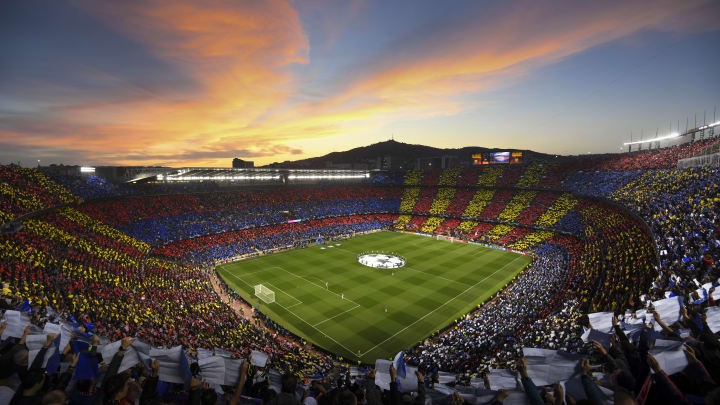Barcelona's stadium: The history & future of Camp Nou
By Sean Walsh

Barcelona's Camp Nou home is the biggest stadium in Europe.
It's one of world football's most iconic venues and has seen plenty of famous moments down the years.
But Barcelona's history isn't solely tied to Camp Nou, and the stadium is set to undergo a major transformation.
Here's everything you need to know about the shared history and future of Barcelona and their Camp Nou home.
What home stadiums have Barcelona played at?
Barcelona's football department initially played their home games at Camp de la Industria from 1908 onwards. Prior to that, they played on several fields across the city, but were forced to play at a permanent home when the club was at risk of dissolution. Camp de la Industria was situated in the L'Antiga Esquerra de L'Eixample district in the south-west of the city and had a capacity of 6,000.
However, the facilities there were not up to scratch and they departed for Camp des Les Corts (in Barcelona's Les Corts neighbourhood) in 1922. When it opened it could hold 20,000, but the club's sharp increase in popularity - particularly after the Spanish Civil War - meant that it had a maximum capacity of 60,000 by the time they left for an even bigger stadium at Camp Nou in the 1950s.
How long have Barcelona played at Camp Nou?
Barcelona left Les Corts in 1957, moving into Camp Nou after three years of construction work.
Located in Hospitalet de Llobregat in the western part of town, Barcelona officially opened the stadium with the blessing of the city's archbishop in September of that year.
The club have played home games there ever since - the 2022/23 season will be their 66th year playing at Camp Nou.
What does Camp Nou mean?
English speakers often refer to Camp Nou as 'the Nou Camp', but this is incorrect - not least because 'Nou' is actually pronounced like 'now' as opposed to 'new'.
'Camp Nou' directly translates from Catalan to 'New Field'. So really it sounds like the name of a state-of-the-art NFL arena.
Barcelona agreed to sell Camp Nou's naming rights to music streaming service Spotify in 2022, and from July of this year the stadium will officially be known as 'Spotify Camp Nou'.
Prior to the completion of the stadium, there were talks for it to be called 'Estadi del FC Barcelona', but this wasn't as popular as the final name.
What is Camp Nou's capacity?
As of June 2022, Camp Nou's capacity stands at 99,354.
However, there were plans - some of which were actually acted upon - for the stadium to be able to hold even more people. When the project of building a new ground away from Les Corts began, club members campaigned for Camp Nou to have a capacity of 150,000. In the end, they settled for 93,053.
Camp Nou was expanded ahead of the 1982 World Cup in Spain so that it could hold over 121,000, but this was reduced to its current capacity just before 2000 when all standing areas were replaced with seating.
Barcelona's record attendance of roughly 120,000 came in a 1986 European Cup tie with Juventus.
Conversely, the club played behind closed doors during the coronavirus pandemic in 2020 and 2021, while a La Liga match against Las Palmas was played without spectators due to political unrest in Catalonia in October 2017.
What are the future plans for Camp Nou?
Camp Nou is about to undergo a facelift that could cost Barcelona north of €600m, making it one of the most expensive stadium developments of all time.
The renovations will see almost a complete transformation of the stadium, with all three tiers of the ground undergoing some form of remodelling, a roof being added and the capacity taken to 105,000.
Barcelona will move out of Camp Nou and into the city's Lluis Companys Olympic Stadium, which used to house rivals Espanyol, for the 2023/24 season. They will then return to their spiritual home but at 50% capacity the following year in a similar fashion to how Real Madrid are playing during renovation works at the Santiago Bernabeu.
Camp Nou's renovations are expected to be complete by the 2025/26 season.
What other matches are played at Camp Nou?
Barcelona Femeni have played a number of high profile fixtures at Camp Nou in recent times, and even drew bigger crowds than the men's team during their run to the 2021/22 Champions League final. The record for largest official attendance at a women's football match was twice broken in 2022, with 91,553 and 91,648 attending games against Real Madrid and Wolfsburg respectively.
Camp Nou is also a home for rugby matches and concerts, while unofficial games played by the Catalonia national team have also taken place there.
Five matches were played at Camp Nou during the 1982 World Cup, and it also hosted the 1989 and 1999 European Cup/Champions League finals.